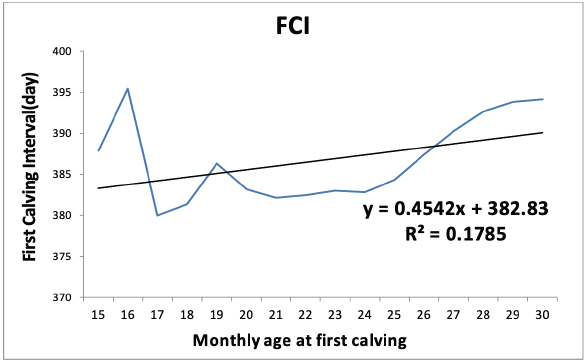Abstract
This study was conducted to improve cow productivity by analyzing the heritability of the first calving interval trait of Hanwoo cows, and to provide basic data that can be used in selecting and culling individual animals for farms. The data used in this study estimated the genetic parameters by collecting the first calving interval and pedigree data of the second parity after the calculation of 311,981 cows born from 1997 to 2017 that were a linear classification test by the Korea Animal Improvement Association. For the basic statistics and variance analysis of the data, PROC GLM of SAS ver 9.1.3 was used, and RenumF90, REMLF90(Misztal et al., 2007) and computerized programmed based on Fortran based on the AI-REML algorithm were used for genetic evaluation. As a result of the analysis, the average value and standard deviation of the basic statistics at the first calving interval(FCI) were analyzed as 384.43±58.36 days, the first calving age(FCA), the short order of FCA was 381.67±64.63 days, 382.11±57.14 days, 382.43±55.73 days, and 382.80±56.33 days in the order of 18 months, 21 months, 22 months, and 24 months. Conversely, the long order of FCA was analyzed as 390.25±63.90 days, 392.65±64.71 days, 393.82±64.88 days, and 394.17±64.86 days in the order of 30 months, 29 months, 28 months, and 27 months. The first calving interval(FCI) was the shortest at 352.71±2.18 days in Gyeonggi-do, followed by 354.80±1.97 days in Gangwon-do, 381.34±55.32 days in Chungcheongbuk-do, 382.56±58.63 days in Jeollanam-do, Jeju-do, and Gyeongsangbuk-do, respectively. The region with the longest FCA was 387.04±60.10 days in Gangwon-do, followed by Jeollabuk-do and Gyeongsangnam-do with 385.81±59.05 days and 385.11±59.47 days, respectively, longer than other regions. It the basic statistics of the FCI according to the offspring sex, the FCI according to the production of female and male was analyzed very similar to 384.08±58.35 days and 384.78±58.37 days, and it was judged that the FCI according to the sex of the second parity after the first parity difference was almost the same. The FCI between the second parity after the first parity season was the shortest at 380.70±63.19, followed by spring and fall at 383.81±53.30 days and 385.98±65.75 days, respectively. The season with the latest FCI was winter, indicating 389.83±56.61 days. The variance analysis results showed that FCI showed a high significant difference (
Figures & Tables

Fig. 1. Least square mean of monthly age at First Calving Interval (FCI)


